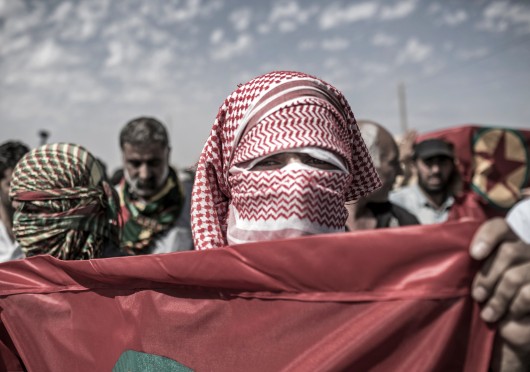
Hundreds of people in the Turkish village of Suruc, near the border town of Kobane in northern Syria, accompany the coffins of three Kurdish fighters who died while battling ISIS militants on Oct. 8.
Credit: Courtesy of TNS
Mushtaq Dualeh was 9 years old the first time she was attacked for being Muslim.
Dualeh was walking with her grandmother around her North Columbus neighborhood just off of Cleveland Avenue, when a group of white and black teenage boys began throwing rocks and shouting the word “terrorist” at the pair.
“At that moment, my grandmother grabbed ahold of me, and we ran,” Dualeh recalled.
Dualeh, a fourth-year in public health development studies and a Somali-American who wears a hijab, said she didn’t understand why she was being called a terrorist.
“Instances like those were intimidating, confusing, and downright scary,” she said. “I remember wondering, ‘why these people accused me of being a terrorist, when I was the one being terrorized’ — when it was me and my family who kept getting hurt.”
Today, the rise of the militant group that calls itself the Islamic State, more commonly known as ISIS, seems to be intensifying Islamophobia, or prejudice toward Islam and Muslims in the United States, one expert said.
The group’s goal is to rule over Iraq and Syria based on its interpretation of the Quran. In the process, they have persecuted and discriminated against people of people of many minorities through murder, rape, enslavement and displacement.
The group became a concern to the American government when it released videos showing the beheadings of two American journalists, James Foley and Steven Sotloff. President Barack Obama responded with a four-step plan to combat ISIS on Sept. 10. This plan included carrying out an airstrike campaign with Iraqi forces on the ground, training and equipping Iraqi forces and the Syrian opposition with weaponry and intelligence, stemming ISIS’s funding, intelligence and foreign membership, and providing humanitarian aid to victims.
On Sunday, the group shot and killed at least 50 people from an Iraqi Sunni tribe in western Anbar province, Iraq’s government said.
The rising threat of ISIS has been increasing Americans’ fear of Islamic extremism, which one expert said is a root cause of Islamophobia.
According to a September survey by the Pew Research Center, 53 percent of Americans are “very concerned about the possibility of rising Islamic extremism in the U.S.,” and a 2013 Pew Research Center report said 42 percent of Americans said Islam is “more likely than other religions to encourage violence among its believers.”
Erik Nisbet, an assistant professor in the School of Communication at Ohio State and an expert on American-Islamic relations, said the perception of Islam as a more violent religion is a key factor of Islamophobia. He also said the rise of terrorism and ISIS feed Islamophobia and the mass media is a contributing factor.
“Since Muslims are 1 percent of the population, everything we know about Islam is from the media,” Nisbet said. “With the media coverage of Islam since 9/11, we have chronically assessable stereotypes about Islam. When this type of crisis rises, it activates these stereotypes among a large segment of the population. You see spikes in anti-Islamic sentiment.”
Nisbet said a fundamental element of Islamophobia is a “monolithic view of Islam.”
“How Islam is practiced in Afghanistan, in Pakistan, in Arab countries, has been formed by those cultures,” he said. “People are seeing religion through the lens of their culture.”
Nisbet added that a monolithic view — or the view that all Muslims are the same — is often the view portrayed in the news. That view, Nisbet said, is not good.
This negativity in the mass media impacts Americans, whose attitudes toward Muslims have declined to 27 percent in 2014 from 35 percent in 2010, according to the Arab American Institute.
But John Mueller, a senior research scientist at the Mershon Center for International Security Studies at OSU, said ISIS is not causing Americans to be more concerned about Muslims in the U.S.
Mueller said ISIS has been painted as an “ultraviolent” fringe group, rather than Islam itself.
Nisbet said the Islamophobic effect of media behavior is a greater threat to the U.S. than ISIS itself.
“Research shows, ironically, that what often predicts radicalization and extremism in Muslims, or any group, is when they feel threatened, when they’re not felt welcome, when they’re in this hostile environment,” he said. “So you’re actually creating the very problem you’re afraid of. It’s a self-fulfilling prophecy.”
The hostile environment Nisbet referred to has been backed up by the AAI. AAI found that the downfall of favorable attitudes toward Muslims poses a threat to their civil liberties. According to its study, 42 percent of Americans support “profiling by law enforcement against Arab Americans and American Muslims.”
Regardless of opinions and statistics, one thing remains clear to Dualeh: Islamophobia exists in America. The harassments, “Look at that towelhead!”, “Go back to your country!”, and “Terrorist!”, continue to echo in her head.


